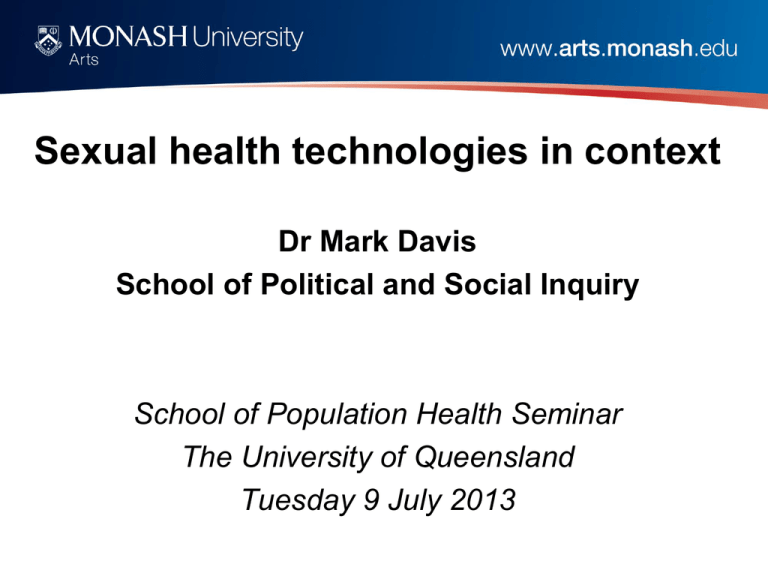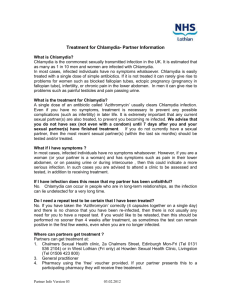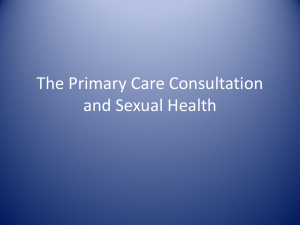
Sexual health technologies in context
Dr Mark Davis
School of Political and Social Inquiry
School of Population Health Seminar
The University of Queensland
Tuesday 9 July 2013
Overview
• More on sexual health technologies
• Social, economic and technological
factors
• Reshaping of sexual health
• Unexpected effects
• Disclosure technologies
Sexual health technologies
• Pre- and Post Exposure Prophylaxis
• HIV self-testing (Frith 2007).
• Online contact-tracing for syphilis (Klausner, et al.
2000)
• E-dating profiles (Levine and Klausner 2005)
• Barebacking websites (Davis 2009)
Sexual health’s technological imaginary
• Assemblage of knowledge production,
relationality and material life in such a
way as to exercise improved control
over the transmission and treatment of
STIs
• Hybrids of diagnostic and social media
tech with ramifications for sexual
decision-making
Social and economic contexts
• Surveillance medicine in affluent countries
(Armstrong 1995)
• Increased lifespans + chronic disease
(Aronowitz 2009)
• More diseases and disease states are being
discovered (Webster 2007)
• Increased expectations/costs
Self-management
•
•
•
•
•
healthdirect.org.au
medibank.com.au
healthcoach4me.com (Glaxo)
lumigenix.com
genetrackaustralia.com
New kinds of clinics
•
•
•
•
Outreach clinics for sexual health, 1970s
Cindy Patton’s Rebirth of the clinic (2010)
Qld geographic and social outreach
PCR testing for chlamydia
Unexpected effects
• Catherine Montgomery’s research on clinical
trials of vaginal microbicides in Zambia (2012)
– microbicide emerged as a gender and relational
technology
• How can we keep up with populations?
• What role can be played by social research?
Disclosure technologies
<David> ...I set up a new profile that said ‘‘Never’’ to safe sex and I
was completely blatant about my HIV status—it was only alluded to
in the former profile...
<Davide> I had changed my old profile to use some of the
euphemisms to allude to POZ status so I presume he did...
<MD> what are some of the euphemisms...
<David> ‘‘Positive outlook on life’’...
<David> My uncompromising stance is less than 12 months old.
<David> Yes.
<MD> What uncompromising stance is that?
<David> That I only have unprotected sex.
<MD> What made u change?
<David> Realizing that I much preferred it.
<MD> What made u adjust yr profile
<David> For the majority of the period since I was diagnosed I had
had only protected sex.
<MD> Can u expand?
<David> Realizing that every man was out for the most pleasure HE
could get—why should I not have the same rule?
<MD> So is this a way for you to get pleasure while reducing HIV
risk?
<David> It is also only in the last 15–18 months that I had realized
there was such a large subculture of POZ men having unprotected
sex.
<MD> What made u realize that?
<David> I think that the number of profiles on gaydar explicit about
that has risen markedly in that period.
<MD> How do you feel about being open about yr status on the
net?
<David> I think it is important (Davis et al., 2006: 166-167)
• www.letthemknow.org.au
Wel com e t o Let Th em Kn ow Ho m e
3:03:53
Home
8 / 0 7 / 1 2 6 :0 3 PM
Time to Let Them Know
STI
Let Them Know
A Service of Melbourne Sexual Health Centre
Doctor Info
Partner Info
Feed Back
Welcome to Let Them Know
Ways to Let Them Know
This website has been developed by Melbourne Sexual Health Centre to help people who have been diagnosed
with Chlamydia, Gonorrhoea, Mycoplasma genitalium, Syphilis and Trichomonas to tell their sexual partners that they
might also be at risk.
It also provides local service information for NSW health residents, this is supported by
NSW STI Programs Unit .
Ensuring partners are tested and treated is an important way of controlling the spread of this infection. As well as
frequently asked questions, this website includes examples of conversations, emails, text messages (SMS) or letters you
can use in informing your partner. It even allows you to send an SMS or email to your partner directly from the site, either
personally or anonymously. Or, if you prefer, you can ask your doctor to help.
Letter
SMS
Email
Talk
STI Fact Sheets
Chlamydia
Gonorrhoea
Mycoplasma genitalium
Syphilis
Trichomoniasis
Doctor Letter
Treatment letters
FAQ on STIs
WARNING: Some people may react badly to being told they are at risk of an STI. If you think one of your partners could
become abusive on hearing this news, do not tell them yourself. Instead, use our anonymous email, SMS or letter or ask
your doctor.
Home | STI | Let Them Know | Doctor Infomation | Partner Information | Feed Back
Copyright © 2010 Melbourne Sexual Health Centre
Chlamydia
Gonorrhoea
Mycoplasma genitalium
Syphilis
Trichomoniasis
SMS
“A message from letthemknow.org.au.
[Name of recipient] u may be at risk of
Chlamydia. Pls have a sexual health check.
See website or phone [Telephone number
supplied] PLEASE DO NOT REPLY.”
Conclusion
• Sexual health technologies have a social and
economic history
• Sexual health clinic is moving outside its walls
• Such contexts point to socio-technical
systems; serendipity; complexity
• How can we expand our own conversation on
sexual health’s new technologies?
References
•
•
•
•
•
•
•
•
•
•
Armstrong, D. (1995). "The rise of surveillance medicine." Sociology of Health and Illness 17(3): 393404.
Aronowitz, R. A. (2009). "The Converged Experience of Risk and Disease." Milbank Quarterly 87(2):
417-442.
Davis, M. (2009). Sex, Technology and Public Health. Houndmills, UK Palgrave.
Davis, M., G. Hart, et al. (2006). "Sex and the Internet: gay men, risk reduction and serostatus."
Culture, Health and Sexuality 8(2): 161-174.
Frith, L. (2007). "HIV self-testing: a time to revise current policy." The Lancet 369(9557): 243-245.
Klausner, J., W. Wolf, et al. (2000). "Tracing a syphilis outbreak through cyberspace." Journal of the
American Medical Association 284(4): 447-449.
Levine, D. and J. Klausner (2005). "Lessons learned from tobacco control: A proposal for public health
policy initiatives to reduce the consequences of high-risk sexual behaviour among men who have sex
with men and use the internet." Sexuality Research & Social Policy 2(1): 51-58.
Montgomery, C. (2012). "Making prevention public: The co-production of gender and technology in
HIV prevention research." Social Studies of Science 42(6): 922-944.
Patton, C ed. (2010) Rebirth of the clinic: Places and agents in contemporary health care.
Minneapolis, U of Minnesota Press,
Webster, A. (2007). Health, technology & society: A sociological critique. Houndmills, Palgrave.












